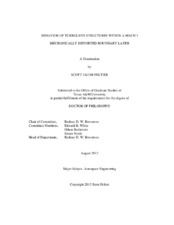| dc.description.abstract | High-resolution particle image velocimetry (PIV) is employed to resolve the velocity fields within a Mach 4.9 mechanically distorted turbulent boundary layer (Reθ ≈ 40,000). The goal of this study is to directly observe the mechanisms responsible for the modified turbulent stresses present in mechanically distorted boundary layers. This is achieved by measuring the effects of the mechanical distortions upon the distribution, population, size, orientation, and energy content of the turbulent structures, and how the perturbed state of these structures is manifested within the ensemble-averaged turbulent stresses. The two mechanical distortions under investigation are 1) streamline curvature-induced favorable pressure gradients (Ip = {-0.08; -0.49}), and 2) periodic arrays of diamond roughness elements (k/δ ≈ 0.07). A smooth-wall, flat-plate boundary layer is also included to establish the unperturbed state of the turbulent structures. The response of the mean turbulence statistics is investigated through ensemble-averaged profiles of Reynolds stresses, indicating the respective influences of pressure gradient effects and surface roughness upon the turbulent statistics. The distortion and reorientation of the large-scale coherent motions is quantified through the determination of the integral length scale and local structure angle from two-point correlations. Detection of individual vortices through the swirling strength criterion λci allows the population distribution of the turbulent eddies to be examined, along with the conditionally averaged hairpin structure.
The baseline and rough-wall stresses showed good agreement when scaled by the smooth-wall friction velocity. Two-point correlations indicate that the reorientation of the large-scale [i.e. O(δ)] coherent structures, coupled with the modified wall-normal fluctuations, is primarily responsible for the modification of the rough-wall Reynolds stresses. The reduced Reynolds stresses observed in the favorable pressure gradients is partially due to the attenuation of the local flowfield around the near-wall hairpin structures, mitigating the mechanism for “producing” turbulence. The rotational rate of the hairpin vortices, measured through the mean prograde swirling strength, was reduced for the favorable pressure gradient models. | en |


